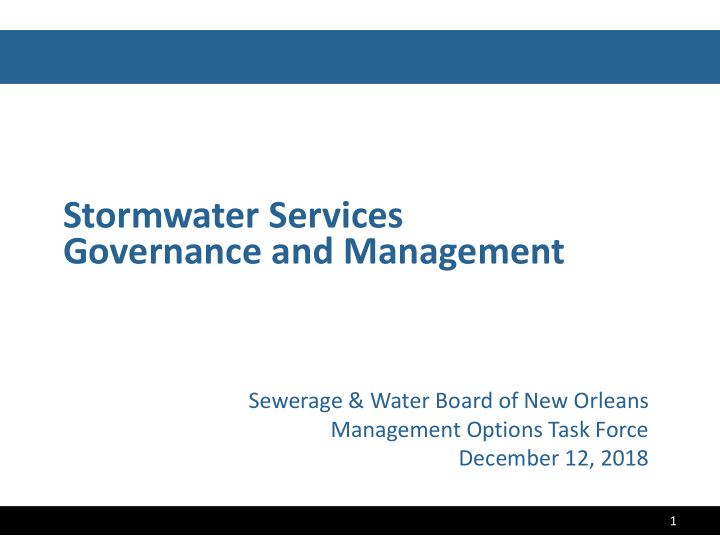



Stormwater Services Governance and Management Sewerage & Water Board of New Orleans Management Options Task Force December 12, 2018 1
Introductions • Andrew Reese – 30+ years in stormwater technical, financial, organizational – Expertise in design, green infrastructure, planning – Over 100 cities: Philadelphia, Charlotte, Nashville, Portland, Halifax, Cleveland, Atlanta, Birmingham, Dallas/Ft. Worth, Australia • Eric Rothstein – 30+ years in water, wastewater, stormwater finance – Municipal Advisor, CPA, EFAB Board – Institutional structuring / regionalization: Atlanta, Detroit, Egypt, Flint, Houston, Toledo 2
Where You Are Going • Repair and manage the pumps and canal systems • Rapidly clean, repair, and transform the collection system • Imperatives: – Achieve efficiency, excellence, transparency, accountability, and equity – Leverage existing organizational, and administrative capacity and authority • Build in flexibility for regional cooperation 3
Institutional Structuring Options • City of New Orleans Department • Privatization • Separate independent utility – City of New Orleans – Multi-jurisdictional / regional • Sewerage and Water Board – Adjunct to status quo – Evolution to alternative • Public benefit corporation “If you don't know Project and Service Delivery Partnerships where you are going, • Traditional you'll end up some • Community-Based place else.” 4
Benchmark Stormwater Utilities • Charlotte – Mecklenburg County • Nashville • Halifax • CSO communities – Philadelphia – DC Water – NEORSD – Louisville 5
Community-Based Model Structure Municipality Service Delivery Entity Provides surety of execution and Ownership and Control adopts shared goals managed retained by the public through performance metrics partner Financial Stakeholders Community Based Design/Build Debt/Equity/Grant Service Delivery O&M (lowest-cost financing) Entity 1. One contract awarded to a design, construction, O&M consortium to operate for a specified time (enabling rapid resource deployment) 2. Private sector may assume more risk in both the short and long term 3. Local hiring and workforce development focus and performance measures 4. Community members involved in entity management / decision-making
Separate Stormwater Utility An institutional entity, typically enabled through state authorization, with utility powers including the ability to impose rates and charges, sometimes taxes, issue debt, invoke eminent domain, etc. – with responsibility for stormwater management, flood control. Benefits Challenges • • Focus of utility enterprise Creation of new Institutional infrastructure – all admin and – Absence of distractions O&M functions – Absence of legacy issues • Establishing efficient billing and • Billing and collection (w/o collection processes revenue sharing) • Coordination with other water • Focused coordination with resource utility functions potential funding / project – One water management delivery providers – Transportation infrastructure • Prioritization of O&M procedures based flooding, SW assets 7
SWU Impacts on Financing • Advantages – New, dedicated revenue stream – Focused grantsmanship • Disadvantages – Risks associated with difficult to collect rates and charges – Dilution (actual or perceived) of support for water and wastewater reinvestment needs 8
Equity and Affordability Considerations • Opportunity to focus investment / reinvestments in previously under-served, flooding sections of City – Address environmental justice / restorative justice options • SWU impervious area (+) charges arguably more equitable mechanism to recover stormwater management / flood protection costs – Flexible rate and credit options • Low Income affordability implications: – Cost recovery aligned to home / parcel sizes – Opportunity to tailor credit mechanisms 9
Lessons Learned • Structure governing board for sound, efficient decision-making – Independent, < 10 members, voting structures designed for compromise/consensus – Qualified, responsive leadership matters – Accountability requires transparency – Institutionalize community engagement (facilitated outside of governance structure) • Build in financial integrity to help ensure resiliency – Private capital requires competitive, market-based returns – Restructuring payments (e.g., acquisition, concessions, franchise fees) typically require same customer base to pay twice for asset base – Favorable financing secured by sound financial policies and risk management – Equitable, stable funding structures (e.g., impervious area charges) – Recognize affordability, historical inequities / EJ issues • Pursue integrated, holistic water management • Evolve institutional structures in response to community needs 10
Logical Steps Forward Collection & Conveyance System Major Network System 1. Create excellence within 1. Create focused & lean S&WB to fix or transform organization as “twin” to S&WB large systems 2. Develop utility fee funding 3. Use alternative / innovative 2. Modify board & governance options for rapid to meet oversight & design/construct/maintain performance goals 4. Work out efficient way to work 3. Rapidly plan & execute with Public Works overhaul or change in 5. Use S&WB administrative pumping systems support Short-term Long-run 11
Questions and Answers 12
Recommend
More recommend